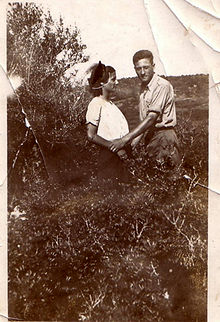Italo-libici (Italian) | |
|---|---|
 An image showing an Italian colonist couple in Libya | |
| Total population | |
| 119,139[1] (in 1939) | |
| Regions with significant populations | |
| Tripoli, Benghazi, Khoms, Misurata. | |
| Languages | |
| Italian, Sicilian, other languages of Italy, Libyan Arabic | |
| Religion | |
| Christianity, mostly Roman Catholicism, minority of Islam. | |
| Related ethnic groups | |
| Other Italians |

Italian Libyans (Italian: Italo-libici) are Libyan-born citizens who are fully or partially of Italian descent, whose ancestors were Italians who emigrated to Libya during the Italian diaspora, or Italian-born people in Libya. Most of the Italians moved to Libya during the Italian colonial period.
The Italian population virtually disappeared after the Libyan leader Muammar Gaddafi ordered the expulsion of Italians in 1970. After the nationalization of Italian companies, only a small number of Italians remained in Libya. On 30 August 2008, Gaddafi and Italian Prime Minister Silvio Berlusconi signed a historic cooperation treaty in Benghazi. Only a few hundred Italians were allowed to return to Libya between 2000 and 2010. In 2006 the Italian embassy in Tripoli calculated that there were approximately 1,000 original Libyan Italians in Libya, mostly elderly people and assimilated Muslim living in Tripoli and Benghazi.